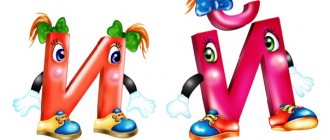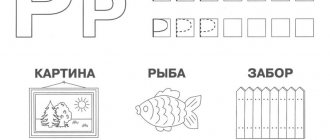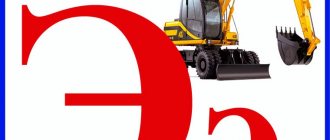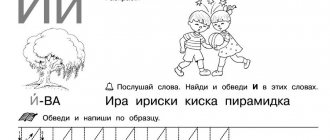Articulation of the sound Zh
Phoneme Ж is a hard and voiced consonant. Its articulation is similar to the pronunciation of Ш, but with tension of the vocal cords, that is, with the participation of the voice.
This is how the articulatory formation of the sound Z occurs:
- the lips are slightly pulled forward and rounded;
- the tongue rises to the upper palate and comes into contact with its posterior surface;
- the tip of the tongue, directed upward, is located behind the upper incisors;
- The sides of the tongue are in contact with the molars.
Letter C
Incorrect pronunciation of the letter C in children is quite common. Options for incorrect pronunciation of C are :
- there is no sound at all (juice - ok),
- it is replaced by something easier to pronounce (dog - shabaka, etc.)
- The child confuses hard and soft C (dog - shabaka).
Pronouncing the letter C requires trained tongue and lip muscles, as well as proper breathing.
The lips smile slightly, the upper and lower incisors are visible. The teeth are almost closed. The wide tip of the tongue touches the lower front teeth. The lateral edges of the tongue meet the lateral teeth of the upper jaw. The back of the tongue and the alveoli form a narrow gap for the exit of a strong and cold air stream. The vocal cords are open and do not produce vocal vibration.
Articulation and breathing exercises will help train a child’s speech apparatus
Exercises should be alternated with each other and performed at a measured count.
- “Whistling” - with clenched teeth, you need to stretch out your lips with a tube, as when whistling.
- “Smile” - the lips stretch into a smile, but the teeth remain open.
- “Brushing your teeth” - you need to open your lips and run the tip of your tongue over your teeth (from right to left and back, on the upper and lower jaw).
- “Watch” - the lips smile, and the tip of the tongue moves alternately to the right and left corners of the mouth. The lower jaw should be motionless.
- “Swing” - the child should try to reach the tip of the nose, the chin, the upper and lower lips, the space between the teeth and the lips of the upper and lower jaw with his tongue. The tongue always remains wide, and the lips do not cover the teeth.
Games with the letter C
- Continue with pure sayings (or even come up with your own using pictures). Sa-sa-sa - a wasp is flying around the yard. Su-su-su - it’s good in the forest now.
- Songs, poems, nursery rhymes.
Nice uncle - Elephant, he loves to listen to fairy tales. Fairy tales are mischievous, the funniest.
The sun is shining clearly - Everything is fine with us! The sun hid behind the forest, the moon is shining... with the letter S.
The magpies are at the magpie Urgently doing their homework: One hundred and forty magpies are scribbling lines merrily.
- Lotto (pictures and cards with images of objects whose names contain the letter C). We take out a picture, say the word, put it on a card with its image. Whoever collects the full set of pictures the fastest wins.
- Come up with a sentence with words. Adults need to prepare pictures in advance (they can show a clock, a dryer, an icicle, a sausage, a braid, etc.)
- Puzzles. Of course, the answer must contain the letter C.
Here is a mountain, and near the mountain there are two deep holes. The air wanders in these holes: It comes in and then comes out. (Nose)
There is a white nail growing under our very roof, but as the sun rises, the nail will melt and fall. (Icicle)
A white blanket lay on the ground, Summer came - it was all gone. (Snow)
- Remember words starting with the letter C. You need to pronounce them one by one. The one who knows more words wins.
- Finger games, nursery rhymes (Finger Boy, White-sided Magpie, etc.)
Tongue twisters with the letter C
- Senya carries hay in the canopy. Senya will sleep on the hay.
- The wasp does not have whiskers, not whiskers, but antennae.
- Senya and Sanya have a catfish with a mustache in their nets.
- Mow, mow, while there is dew. Dew away - and we're home.
- The sunflowers look at the sun, and the sun looks at the sunflowers.
- The cream in the pussy's bowl has turned sour.
- Pussy ate soup from a bowl. The bowl is empty, the pussy is full.
- Millet flying in Frosya's field. Frosya takes out the weeds.
- Sasha is perfection, and also improves herself.
Causes of defective pronunciation
There are several factors that prevent you from mastering the pronunciation of the sound Z:
- anatomically incorrect frenulum of the tongue;
- a high and deformed hard palate that cannot accommodate the tongue;
- defects of the jaws and dentition, cleft palate;
- open, protruding bite.
In these cases, the help of an orthodontist or surgeon is required. But more often, the reason for incorrect pronunciation of F is a lack of understanding of what articulation should be, or the child copying the distorted speech of people around him. In these cases, correction of incorrect pronunciation is possible using speech therapy methods.
Staging the sound Z in stages for a speech therapist
Speech therapy work includes 3 stages of adjusting sound pronunciation with gradual complication of tasks:
- staging - learning correct articulation, pronouncing an isolated sound;
- automation - sound reproduction in syllables, words, phrases;
- differentiation - auditory perception of a phoneme with the ability to distinguish it from similar sounds.
Speech hearing
Correct speech of a child is achieved through speech hearing. To pronounce sounds correctly, the child must clearly perceive them by ear.
Determine the location of sounds in a word: at the beginning, middle or end of the word. Hear whether a given sound is hissing or not.
Distinguish sounds against the background of similar sounds:
- In an isolated position
- In syllables
- In words
Expert opinion
Margarita Sergeevna S.
Speech pathologist and speech pathologist with 15 years of experience working in various speech correction centers with children of different ages.
With dysarthria, the production and automation of hissing sounds becomes more complicated and requires more time and individual training.
Articulation gymnastics for the sound Zh
First, the speech therapist teaches the preschooler to correctly place the articulatory organs when pronouncing the sound Z. The most common and effective method is imitation: the adult shows movements with the lips and tongue, the child repeats. It is advisable to place a mirror in front of the preschooler. Then the child will see how correctly he repeats the movements of the speech therapist.
Young children may find it difficult to hold their tongue in a certain position. Then, in the first lessons, the speech therapist uses probes—fixing and massage devices.
Articulation gymnastics is the first stage of each speech therapy session. Here are the optimal exercises for setting the F:
- “Damn”: the mouth is slightly open, the relaxed tongue is spread out on the lower lip, the upper row of teeth is visible. Duration - 10 seconds.
- “Yummy”: the tip of the tongue is relaxed, licks the lower and then the upper lip in a circular motion.
- “Cup”: the tongue is arched into a cup shape, the sides are in contact with the upper molars.
- “Glue the toffee”: the relaxed tip of the tongue lies on the lower lip, and a piece of toffee or other chewing candy should be placed on it. Then the child must stick this candy to the front of the roof of the mouth with his tongue. At the same time, he should not move his lower jaw, and his mouth should be open no more than 2 cm.
- “Mushroom”: the lips are stretched in a smile, the teeth are visible, the mouth is slightly open, the relaxed tongue is pressed with its entire surface to the palate. Then you need to open your mouth wide so that your tongue looks like a mushroom cap and its frenulum looks like a stem.
- “Accordion”: the mouth is slightly open, the lips are stretched in a smile, the tongue is pressed to the palate. Holding your tongue in its original position, you need to open and close your mouth, fixing it in one position or another for 3-10 minutes. The frenulum of the tongue will relax and tighten, like the bellows of a musical instrument.
Letter L
This is one of the most difficult letters to pronounce. Children learn to pronounce it one of the last. However, it is important to start working on correct pronunciation as early as possible.
How to pronounce the letter L correctly?
The lips stretch into a smile, and the teeth are clenched. The tongue can rest against the teeth, the gap between the upper and lower teeth, or the alveoli. The sides of the tongue do not interfere with the free passage of the air stream.
There are several options for incorrectly pronouncing the letter L.
- complete absence of this sound (spoon-spoon)
- replacing with a simpler sound, for example, U
- distorted pronunciation (similar to S, J or R)
- inability to distinguish between hard and soft L.
It is worth trying the following articulation and breathing exercises :
- «Smile". Keep your lips stretched out in a smile, counting to 10. Your mouth should be closed.
- «Locomotive". The lips stretch into a smile, the teeth are clenched, the tongue presses on the teeth, like on a locomotive whistle, and adds a voice. This produces the sound L.
- «Dog". The child stretches his lips in a smile, shows his teeth and bites the tip of his tongue. Then you need to start breathing like a hot dog. It is important to ensure that the air passes through the mouth and not through the nose. Then you need to connect your vocal cords and pronounce YYY or AAA. There is no need to puff out your cheeks.
- «Horse." Smiling widely and showing your teeth, you need to click your tongue (as if a horse is galloping). The lower jaw should remain motionless.
- Move your tongue in your mouth alternately to the right and left.
- «The breeze is blowing." The lips stretch into a smile, the mouth opens slightly and the tongue is bitten. The child begins to blow on the cotton wool in the palm of the adult.
- «Pencil". You need to take a deep breath through your nose and exhale a stream of air through your mouth so that you can roll a pencil across the table.
Games with the letter L
- “Say the sentence.” These can be rhyming sentences that you need to come up with yourself (for example, lo-lo-lo - it’s warm outside). The child can also continue the lines of poems known to him (for example, A. Barto “The Little Frogs”).
- "Box of Pictures" Let the child name the objects shown in the pictures (the names of which contain the letter L). Then you need to make a sentence out of these few words. For example: a bowl of raspberries and a lamp are on the table.
- "What's missing?" On the table there are objects whose names contain the letter L (spoon, boat, frog, etc.). For a few seconds, the child turns away from the table, and the adult hides the object. You need to name the “missing” thing.
- Rhymes and songs.
It ran away, it ran away, the milk ran away. I caught it with difficulty, Being a mistress is not easy!
Grandfather planted onions and grew an onion. The grandson saw the bow and tore off the forelock of the bow. An amazing thing: Tears are falling - from the grandson!
Here are the needles and pins crawling out from under the bench. They look at me, they want milk.
Tongue twisters with the letter L
- Lena was looking for a pin, and the pin fell under the bench.
- On the river shallows we came across a burbot.
- There is no ring near the well.
- The Queen gave the gentleman a caravel.
- Our Polkan from Baikal lapped. Lakal, lakal, but Baikal did not become shallow.
- Mom washed Mila with soap.
- Antipas had one linden tree, but Philip planted seven linden trees.
- Crucian carp, don't get into the hole! A crucian carp got stuck in a hole.
- Karl was putting the onion on the chest. Clara was stealing onions from the chest.
Breathing exercises
When the articulation of the sound Ж is correct, an air flow flows outward along the tongue. When articulation is defective, this flow is absent. The goal of breathing exercises is to teach a preschooler how to breathe correctly when pronouncing the sound Zh.
When a preschooler performs breathing exercises, the speech therapist must monitor his body movements. It is important that the child’s shoulders do not move, and that the chest rises calmly and low when inhaling. Relaxed and short inhalations should go through the mouth, and exhalations should be calm and leisurely.
Recommended breathing exercises when placing F:
- Blow off a paper butterfly lying on your palm. The further she flies, the better.
- Smile, arching your tongue upward and hiding its tip behind the lower row of teeth. Exhale.
- Exhaling deeply and briefly, extinguish the candle flame, while saying a long “fu”.
- Smile with your mouth slightly open, cup your tongue, and press the relaxed tip to your upper lip. The child should, exhaling air through the hole between the cupped tongue and lip, blow off a piece of cotton wool placed on the nose.
- Bring a bottle with a narrow neck to your lower lip and blow into it to make a sound.
How to conduct speech therapy sessions with your child at home. Adviсe
Classes should be held in a playful way. This way the child will not be wary of them, nervous or complex.
- You cannot overly insist on exercises and force your child. Classes should bring him pleasure. Only in this case will your pronunciation quickly begin to improve.
- The lesson should not exceed 15 minutes, and articulation gymnastics (warm-up) should last at least 5 minutes. This is how the exercises will bring the greatest benefit.
- You should not repeat breathing and voice exercises more than 4-5 times. Children tire quickly, use more oxygen than usual, and may feel dizzy.
- The child should not have a cold (stuffy nose, sore throat), otherwise breathing exercises will be performed incorrectly and will not be beneficial.
- To enhance the effect of classes, it is necessary to consolidate skills throughout the day. Children will have fun playing and saying tongue twisters together with adults. You can do this both at home and on a walk.
- You can invite your child to act as a teacher. Let him “teach” his favorite toy to pronounce a letter.
- Games and exercises for fine motor skills - modeling, coloring, designing letters - will help develop speech.
- Be sure to praise your baby. It is important for him to feel his achievements.
Exercises for making the sound Z
The phoneme Ж is easy to place from Z, Ш or R. But this is relevant if the preschooler pronounces the listed sounds correctly. Here are the relevant exercises:
- Setting from R. The child pronounces the syllable “ra”, at this moment the speech therapist, using a probe, eliminates the vibration generated when pronouncing R. The sound changes to Zh. The exercise is repeated until the preschooler learns to pronounce the syllable “zha”.
- Production from Z. The preschooler pronounces “for” in a drawn-out manner. At the same time, the speech therapist lifts the tip of the tongue to the palate with a probe and fixes it behind the upper incisors.
- Setting from Sh. The simplest option that does not require a probe. The speech therapist simply explains to the child how to connect the vocal cords when pronouncing Sh.
A small digression. Sound or letter?
Sound and letter are inseparable from each other. But often even adults confuse these concepts, not understanding the difference between them.
In fact, everything is very simple. What we speak and hear are the sounds of the Russian language. And what we see and read in a book, notebook, computer monitor are letters.
Children first learn to reproduce sounds (speak) and only then begin to write letters (denote what is said graphically).
But due to the fact that we are almost always asked the question: “How to teach a child to say the letter R or the letter Sh?”, we believe that the difference between the letter and the sound in this case is not fundamental. For ease of understanding and reading the article, we chose a single and The term “letter” is familiar to most readers.
Setting the sound Z for individual lessons
The performance of F in a playful form is divided into 3 stages. The first stage is a demonstration of how the articulatory organs should be positioned when pronouncing a sound.
Second phase
This stage includes articulation and breathing exercises, followed by practicing the isolated sound Z. The following exercises are used:
- “Beetles”: the speech therapist shows the preschooler an image of flying bugs and asks them to remember how insects buzz over summer grasses. Children make a sound.
- “Bees”: the game is played in a group, some of the children become bees, the other part become flowers. The teacher invites the students to show how bees circle over flowers and collect nectar. Children pretending to be bees run around their friends, buzzing as they do so.
- “Web”: a group game, some children stand in a circle, but do not hold hands - this is a web, other children pretend to be flies. The second ones run between their comrades, run inside the circle, run out, while buzzing. At the teacher’s command, children standing in a circle grab each other’s hands. Children who do not have time to run out of the circle are flies caught in a web. They also stand in a circle, that is, the web becomes larger. The game continues until the last fly remains. This player becomes the winner.
Third stage
At this stage, the pronunciation of Ж in words and sentences is practiced. It can be started only after the preschooler learns to clearly pronounce an isolated sound.
For classes you need paired pictures depicting objects and scenes. The object images show objects whose names contain the sound Zh. The main thing is that it should not come at the end of a word or before a voiceless consonant phoneme. And plot images should represent the plots with which the objects depicted in other pictures are connected. For example, for the picture “fireman” the pair will be an image of a burning building.
With these pictures, children perform the following tasks:
- The teacher shows an object image. Children name the depicted object.
- The teacher shows plot pictures and asks what object is missing from them. Children answer, look for the corresponding object picture.
- The teacher asks why this or that object is needed. The students answer in detail. For example, “a knife is needed to cut food into pieces.”
Prevention of sound pronunciation correction and prediction
In addition to the speech therapy classes that the child attends in kindergarten or speech school, homework to eliminate speech disorders and sound correction is also recommended. Additional work with parents will help reinforce the material covered.
The teacher can invite parents to perform some exercises from a complex of articulation or breathing exercises with their child at home. If the baby still does not always correctly differentiate the sound, and in free speech replaces it with a similar sounding one, then adults are recommended to focus on this, offering the correct option.
Thus, work on correcting sound pronunciation will be carried out continuously: in the garden, on a walk, at home, which will lead to positive results.
The sooner speech therapy work begins, the sooner speech will become correct and all sounds will be brought to automatism.
Tasks for automating sound
Automation also takes place in stages, it involves consolidating correct articulation in syllables, then in words and sentences.
Automation of the sound Ж in syllables
The child consolidates the pronunciation of Zh in the syllables “zha”, “zhi”, “zho”, “zhe”, “zhu”. Next, pronunciation in a syllable series is used. For example: “zhu-zhu-zhu”, “zha-zha-zha”. Then there are rows with different syllables, for example: “zho-zhe-zhu”, “zha-zho-zhi”. To make things more complicated, a fourth syllable is added, for example: “zho-zha-zhi-zhu.”
Automation of the sound Ж in words
The speech therapist invites the preschooler to pronounce words that include the above syllables, as well as combinations of consonants “zhg”, “zhg”, “zhb”, “zhn” and others. First comes the automation of words in which the specified syllables are the first (jelly, heat, giraffe, reaper), then the last (luggage, leather, fire, friendship) and, finally, in the middle (pajamas, glutton, cake).
Clear automation is important in words that contain consonants: clothes, scissors, wait, curd. It is also important to work on words that have two phonemes F: ground beetle, zhizha, thirst, buzz.
Automation of the sound Ж in sentences
The child repeats after the speech therapist phrases where both words contain the sound Z. For example: a beetle is buzzing, yellow pajamas, a burn is burning, a leather jacket, a fat pie.
Next comes automation in multi-word sentences. The child reads them:
- a fat toad lives in a puddle;
- red saffron mushrooms grew along the path;
- Zhora eats gooseberries, and Zhenya eats blackberries;
- the husband works as an engineer, and the wife is an artist.
Pronunciation of pure sayings like these is used:
- zha-zha-zha - the toad drove away the snake;
- zhu-zhu-zhu - I’m not friends with beetles;
- zhi-zhi-zhi - tell me about the animals;
- Same, same, same - the saffron milk cap rides on a hedgehog;
- jo-jo-jo - I feel fresh with ice cream.
The child learns and recites from memory a short poem in which words with the J sound are often used.
When to seek help from a speech therapist
You shouldn’t delay going to an appointment with a speech therapist. The sooner work on your baby’s speech begins, the faster he will learn to speak beautifully and clearly. It is necessary to consult a specialist in the following cases:
- At 3-4 years old, a child cannot stretch out his lips like a tube, puff out his cheeks, stick out his tongue, touch the palate with it, or reproduce the simplest rhythm.
- After 3.5 years, the baby skips syllables in words and confuses their places.
- At 4.5 - 5 years old, a preschooler does not speak in coherent phrases and confuses gender, number and case in sentences.
- The child speaks through his nose.
- He chokes on words, unable to keep up with his thoughts.
- The baby swallows the syllables.
- He doesn't have enough breath to pronounce the phrase.
- The child speaks monotonously.
- The preschooler does not strive to communicate and discuss what he saw, heard, etc.
- Homework on incorrect pronunciation of letters does not bring the expected effect.
- The child has congenital anomalies - cleft lip, short ligament on the tongue, decreased hearing, etc.
A child’s correct speech is not formed immediately. There are age standards that determine at what age a child should be able to pronounce a particular letter.
If a child cannot pronounce a certain letter correctly, parents can teach him at home.
Correct pronunciation requires trained muscles of the lips and tongue, as well as proper breathing. Articulation and breathing exercises, as well as games and tongue twisters to consolidate the acquired skill, will help teach your child to pronounce letters correctly.
It is imperative to encourage and praise your child for his successes. Seeing the support of adults and the effect of the work done, the child will enjoy the classes. And this is the key to a good result. This way the baby will learn to correctly pronounce even such complex letters as R, Ш, Ж, Л, С.
If you liked the article, please share a link to it








